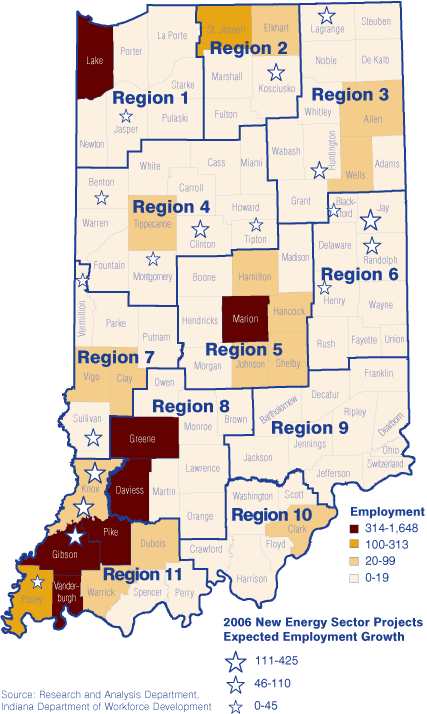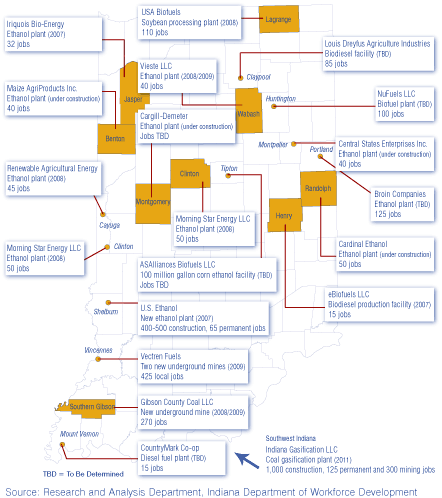Is Indiana Ready to Be an Emerging Leader in the Biofuels Industry?
You cannot go long in today's world without hearing conversations, sound bites, commercials or debates about the energy crisis, our dependence on foreign oil and the looming threat of global warming. But what does this mean for the Hoosier workforce? There is a steady stream of regular announcements concerning new ethanol, biodiesel and coal gasification plants sprouting up around the state. What do we know about these new technologies and the types of jobs that these developments will bring? Does the Indiana workforce have the skills and experience necessary to fill these positions?
In 2006, there were 18 proposed ethanol, biodiesel and coal gasification projects (new and expansion sites) in Indiana (see Figure 1). According to the Indiana Corn Marketing Council, at least 20 ethanol plants alone have been proposed since 2005. Controversy still surrounds many of these projects. The debate continues over which new technology will yield the greatest economic benefit with the highest energy efficiency and least damaging environmental impact. Yet if these projects are approved, all of them will be using new technology to access resources in the Hoosier Heartland, such as coal, animal waste, corn and soybeans.
Figure 1: Energy Sector Expansions and Job Announcements, 2006
As a result of these expansions, thousands of new jobs have been announced, including occupations in advanced manufacturing, construction and extraction. These new plants will also require people to fill managerial and leadership positions. Some jobs will require advanced technology skills and could pay higher wages than Indiana manufacturing jobs of old. The projects are estimated to add more than 1,500 construction jobs (up to 500 may be permanent) throughout the state. The average wage for construction/extraction occupations is $36,855. (1) Many of the permanent jobs will be in chemical manufacturing and mining. The average wage for employment in these related industries is slightly higher at $41,934. Many of these occupations do not require postsecondary education; however, a moderate to long-term level of on-the-job training or previous work experience may be required. The typical skills required by these jobs include equipment maintenance, equipment selection, installation, operation and control, operation monitoring, repairing, and troubleshooting. Table 1 lists the types of jobs and the required education and skills.
Table 1: Jobs and Experience Required in the Chemical Manufacturing (Biofuels) and Mining Industries
Where We Are
Indiana's workforce has a strong historical precedent of a vibrant manufacturing industry. In the first quarter of 2006, 550 businesses in mining and related biofuel manufacturing industries employed an average of 12,042 workers statewide. However, contractions, company reorganizations and relocations in recent years have created a large pool of dislocated workers. According to mass layoff statistics for the mining, manufacturing, utilities and construction industries, (2) a total of about 6,750 layoffs occurred at 48 establishments throughout the state dating back to 2001. The highest concentration of these layoffs was located in southwest Indiana, with a total of 4,304 layoffs at 36 establishments in economic growth regions (EGRs) 7, 8, and 11. Fortunately, this is where several of the new developments will occur (see Figure 2). Some of the announcements pledging to bring the greatest numbers of jobs are located in these southwest regions of the state.
Figure 2: Energy Sector Employment and Attraction Projects, 2006:1

A major source of labor supply for the energy industry expansion will be supported by dislocated workers who predominantly come from construction, production and extraction occupations. These jobs typically require moderate- to long-term on-the-job training. Only a few occupations require workers to have a bachelor's degree. This pool of workers has a substantial amount of work experience and their skills will transfer well to these new jobs in biofuels and other energy sector initiatives.
Where We Are Headed
In the southwest region of the state (EGRs 7, 8 and 11) more than 12,000 job applicants from Indiana's Department of Workforce Development (DWD) job-matching system reported 12 months or more of related experience in mining, construction and production occupations. (3) The numbers of job applicants in each of the occupations specific to the biofuels and mining industries are listed in Table 1. Of those with more than one year of experience, the average level of experience is a little over seven years. More than 10,000 of these applicants report having attained some college, more than 2,500 report having a bachelor's degree, over 3,000 report having an associate's degree and approximately 500 report having a postsecondary vocational degree.
Table 1: Jobs and Experience Required in the Chemical Manufacturing (Biofuels) and Mining Industries
However, fewer applicants possess employment experience in occupations that emphasize managerial skills, information technology skills, and interpersonal skills, such as coordination, instructing, negotiation, persuasion, service orientation, social perceptiveness and time management. Training and education that targets these skill areas are needed to fully develop the potential of this emerging workforce. Assessment of applicants using WorkKeys or other skill-assessment tools (and providing additional training or retraining as appropriate) will prove valuable in preparing the available workforce for the specific tasks required for the new, high-tech jobs being created in the biofuels industry.
Are We Ready?
This initial glance results in a fair degree of confidence in Indiana's ability to fill many of the projected new jobs with a skilled and experienced workforce; nevertheless, there is room for opportunity and growth. In the 21st century economy, employers increasingly demand workers with advanced technology and computer skills. Although these energy-related expansions are heavy with jobs for the manufacturing, mining and construction industries, many of the added jobs will require new skill proficiencies. Indiana's Strategic Skills Initiative (SSI) identified skill shortages throughout the state in the following areas: critical thinking, complex problem solving, science, mathematics, reading comprehension and active (lifelong) learning. The SSI also pointed to shortage areas including advanced manufacturing and medical technology.
Many national articles also emphasize shortage areas in science, engineering and technology, as America faces increased global competition. American (and Indiana) workers at every skill level are in direct competition with workers throughout the world. Indiana and the United States can maintain a competitive advantage with increases in education and training that will lead to innovation and creativity. (4)
Conclusion
The Indiana workforce is ready to fill many posts for the projected ethanol, biofuel and coal mining plants. Experienced workers and an emerging workforce with growing levels of educational attainment will ensure that Indiana remains a powerful hub of manufacturing (chemical and otherwise), mining and construction. WorkOne Centers (5) will direct dislocated or underemployed workers to this expanding industry and, with increased focus on the educational and skill shortages that exist, Indiana will be well able to meet the challenge of this expanding, high-tech sector.
Notes
- Based on the staffing patterns of construction/extraction occupations in mining and biofuels related industries: www.hoosierdata.in.gov/dpage.asp?id=24&view_number=2&menu_level=smenu1&panel_number=2.
- The Mass Layoff Statistics (MLS) program measures job losses or separations when an establishment's employees file at least 50 initial claims for unemployment insurance during a consecutive five-week period. MLS does not track smaller industry cutbacks and often misses dislocated workers who are offered packages, or are let go over a period of time.
- DWD CS3 System as of December 2005.
- National Center on Education and the Economy, the Commission on the Skills of the American Workforce, “America's Choice: high skills or low wages!” 1990, available at www.ncee.org/wp-content/uploads/2013/09/Americas-Choice-High-Skills-or-Low-Wages.pdf; Richard B. Freeman, “Investing in the Best and Brightest: Increased Fellowship Support for American Scientists and Engineers,” The Hamilton Project, December 2006, available at www.hamiltonproject.org; The National Association of Manufacturers (NAM)—2005 Skill Gap Report.
- WorkOne Centers are designed as one-stop shops, able to assist job seekers and the unemployed with a wide range of employment and training services. For more information, call 1-888-WORK-ONE or visit www.in.gov/dwd/job_seekers/workone_centers.html.
Allison Leeuw, Research and Analysis Department
Advanced Economic and Market Analysis Group, Indiana Department of Workforce Development


